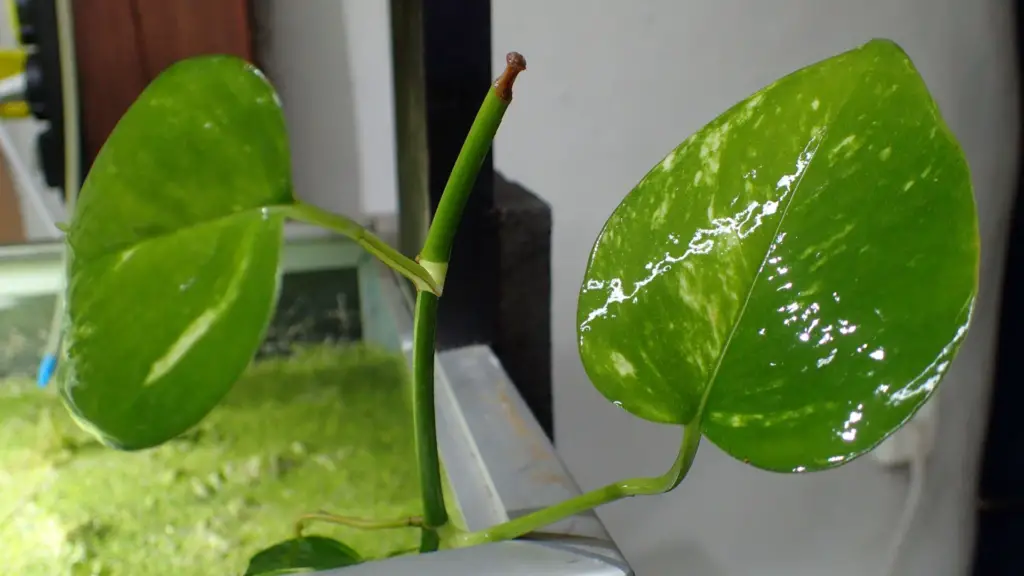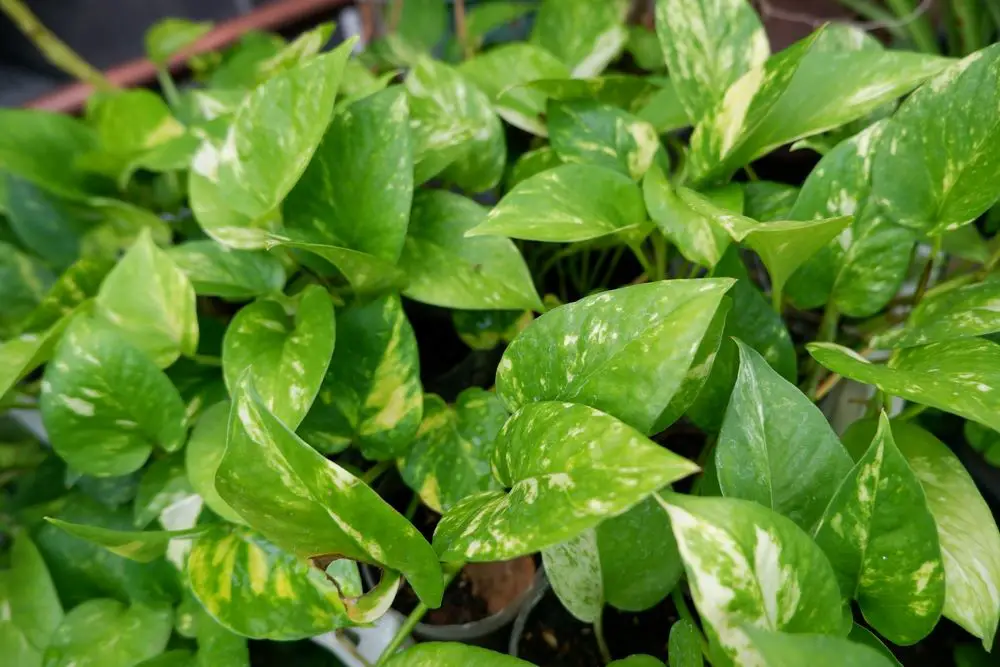Ah, the age-old question that has puzzled many a shrimp keeper: Can I add a pothos plant to my shrimp tank? I remember the days when I would stand in front of my neocaridina tank after watching a few youtube videos with a lush pothos plant in hand, wondering if it would be a match made in aquatic heaven or a recipe for disaster.
videos with a lush pothos plant in hand, wondering if it would be a match made in aquatic heaven or a recipe for disaster.
Yes, you can add a pothos plant to a shrimp tank, but it depends on the type of tank. Pothos does well in a standard neocaridina tank with neutral parameters and inert substrate but may not be suitable for tanks with active soil, as it can strip nutrients and shorten the soil’s lifespan.
You see, my shrimpfam, I’ve been down this road before. I’ve faced the challenges of balancing the nutrients in an active soil tank, only to watch the pothos plant greedily gobble them up, shortening the soil’s lifespan. I’ve also marveled at how beautifully the pothos thrived in a bog-standard neocaridina tank with neutral parameters and an inert substrate.
Through trial and error, over the span of several years, I’ve learned the ins and outs of this delicate balance. And now, dear reader, I’m here to share my wisdom with you. Whether you’re a seasoned shrimp keeper or just starting out, this guide will provide you with the insights you need to make the right decision for your tank.

What are the benefits of adding pothos plants to a neocaridina shrimp tank?
First and foremost, pothos plants are known for their exceptional ability to absorb and remove toxins from the water, such as nitrates. This not only helps in maintaining water quality but also creates a healthier environment for our beloved shrimplets. Imagine having a natural water purifier right in your tank, working tirelessly to keep things fresh and clean.
But that’s not all. Pothos plants also provide a natural and aesthetically pleasing element to the tank. Their vibrant green leaves create a beautiful contrast with the aquatic scenery, adding a touch of nature’s elegance. It’s like having a piece of the rainforest right in your living room.

And let’s not forget about the shrimp themselves. These curious little creatures love to explore, and the pothos plant offers them a playground of leaves and roots to climb and forage. It’s a shrimp’s paradise, providing both entertainment and hiding spots, making them feel right at home.
Lastly, the pothos plant is relatively easy to care for, making it a great choice for both novice and experienced shrimp keepers. It’s a hardy plant that doesn’t demand too much attention, yet it rewards you with a thriving aquatic environment.
So, next time you find yourself pondering the addition of a plant to your neocaridina tank, give the pothos a thought. It might just be the perfect companion for your shrimp nation.
How can pothos plants negatively affect an active soil shrimp tank?
Ah, the active soil shrimp tank, a delicate ecosystem that requires careful attention and balance. Now, introduce a pothos plant into this environment, and you might find yourself in a bit of a pickle. Let’s explore why, shrimpfam.
Active soil is designed to provide essential nutrients to the plants and shrimp within the tank. It’s a rich and fertile ground that supports the growth and well-being of the entire aquatic community. But here’s where the pothos plant can throw a wrench into the works.
You see, pothos plants are known for being nutrient-hungry. They have an insatiable appetite for absorbing nutrients from the water, and they don’t discriminate between good and bad. While this might be a boon in a standard neocaridina tank, it can lead to trouble in an active soil environment.

The pothos plant’s relentless nutrient absorption can strip the water of essential elements, depleting the soil’s richness over time. It’s like having a guest at a dinner party who eats all the appetizers before anyone else gets a chance. The result? A shortened lifespan for the active soil, leading to an imbalance in the tank’s ecosystem.
This imbalance can affect the overall health and stability of the tank, impacting both the plants and the shrimp. It’s a delicate dance, and the pothos plant’s voracious appetite can lead to a misstep, causing a cascade of issues that might be challenging to rectify.
So, while the pothos plant might be a welcome addition to some shrimp tanks, it might be best to think twice in an active soil environment. It’s a lesson I’ve learned through experience and one that I hope helps guide you in your shrimp-keeping journey.
Remember, shrimpfam, knowing your tank and its unique needs is the key to a thriving aquatic world.

What are the alternatives to pothos plants for shrimp tanks with active soil?
Navigating the world of active soil shrimp tanks can be a bit like walking a tightrope, especially when it comes to choosing the right plants. While pothos plants might be off the menu, fear not, shrimpfam! Plenty of alternatives can thrive in this environment without upsetting the balance. Let’s explore some of them.
One popular alternative is the Java fern, It’s like the polite dinner guest who knows just how much to eat without overindulging. Java ferns can add beauty and complexity to the tank without robbing the soil of its richness.
Another option to consider is the Anubias plant. Known for its lush green leaves and slow growth, Anubias is a gentle addition to an active soil tank. It’s not as nutrient-hungry as the pothos, allowing the soil to maintain its vitality. Think of it as the calm and considerate neighbor in the aquatic community.
Floating plants like duckweed or water lettuce can also be a great choice. They provide shade and shelter for the shrimp without digging into the soil’s nutrients. It’s like having a floating garden that adds charm without taking away from the soil’s essence.
And let’s not forget about mosses like Java moss or Christmas moss. These provide excellent hiding spots for shrimp and add a touch of natural elegance. They coexist harmoniously with active soil, creating a symbiotic relationship that benefits the entire tank.
Choosing the right plants for an active soil shrimp tank is a bit like crafting a well-balanced meal. You want flavors that complement each other without overpowering the main dish. By understanding the unique needs of your tank and selecting plants that align with those needs, you can create a thriving ecosystem that both you and your shrimplets will love.
So go ahead, explore these alternatives, and let your shrimp tank flourish!

Conclusion: Pothos Plants and Shrimp Tanks – A Delicate Balance
In summary, the relationship between pothos plants and shrimp tanks is complex, filled with potential benefits and pitfalls.
While these plants can be a wonderful addition to a standard neocaridina tank, their nutrient-hungry nature may not be suitable for tanks with active soil. Understanding your tank’s specific needs and choosing the right plants, whether it’s the Java fern, Anubias, or other alternatives, is key to creating a harmonious and thriving environment for your shrimplets.
On a final note, shrimp keeping is a journey filled with discovery and learning. If you need guidance or have any questions, please don’t hesitate to reach out. If you can’t find me here, check out Aquarium Shrimp Keeping on Facebook.
Happy Shrimp Planting? shrimpfam!
FAQ: Pothos Plants in Shrimp Tanks and Aquariums
Q. Is Pothos safe for aquariums?
A. Yes, Pothos is generally safe for aquariums and is often used to absorb toxins like nitrates. However, care must be taken with specific tank setups, such as those with active soil.
Q. What plants are safe for shrimp tank?
A. Many plants are safe for shrimp tanks, including Java fern, Anubias, duckweed, and various mosses like Java moss. These plants provide shelter and do not compete aggressively for nutrients.
Q. Do Pothos reduce nitrates?
A. Yes, Pothos plants are known for their ability to reduce nitrates in the water. They absorb these compounds, helping to maintain water quality and create a healthier environment for aquatic life.
Q. Are Pothos plants toxic to betta fish?
A. Pothos plants are not generally considered toxic to betta fish or other common aquarium inhabitants. They can be used in betta fish tanks to help control water quality.
Q. Are pothos toxic to animals?
A. Pothos plants can be toxic to some animals, particularly cats and dogs, if ingested. In an aquarium setting, they are typically safe, but care should be taken if you have pets that might chew on the plant.
Q. Do pothos give off oxygen?
A. Like other plants, Pothos does give off oxygen through the process of photosynthesis. This can contribute to the oxygenation of the water in an aquarium, benefiting the aquatic inhabitants.
